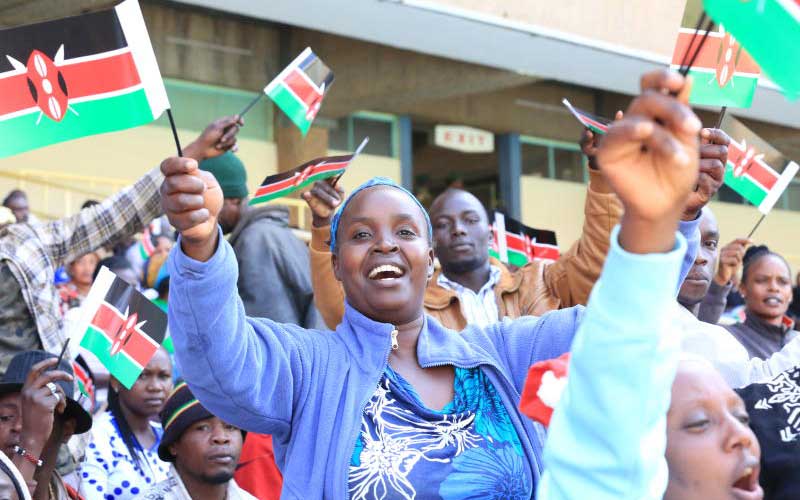
Kenyans at a past Jamhuri Day celebration at Kasarani Stadium in Nairobi. KNBS has released the composition of Kenyans based on ethnic groupings. [File, Standard]
The Kenya National Bureau of Statistics (KNBS) on Friday released a breakdown of the 2019 population and housing census results.
The data tabulates the distribution of Kenya’s 47.6 million population according to socio-economic characteristics.
This includes education; labour participation; housing conditions and amenities; agriculture and livestock; disability; religion and ethnicity; Information and Communication Technology (ICT); and ownership of household assets.
According to the data, Kikuyu is the largest ethnic community with 8,148,668 people and the smallest is the Dahalo at 575.
READ MORE
Scientists train rats to detect smuggled wildlife trophies
Wildlife census kicks off in Tsavo
The Luhya who are grouped into 19 sub-communities are the second-largest bloc with 6,823,842 people. They are followed by the Kalenjin who number 6,358,113.
At 5,066,966 people, the Luo take the fourth spot and Kamba’s 4,663,910 at fifth.
Kenyan Somali are 2,780,502 while the Kisii stand at 2,703,235. The Mijikenda are 2,488,691 and Meru 1,975,869.
According to KNBS 33,358 Kenyans did not want to identify with any ethnic group while 183,023 stated they are Kenyans.
The report further lists:
Kenyan Asians 47,555
Kenyan American 596
Kenyan Arabs 59,021
Kenyan Europeans 1,738.
Below is the full distribution of Population by Ethnicity/Nationality
The data shows that majority (85.5 per cent) of the population are Christians with Protestants, Catholics and Evangelical churches accounting for 33.4, 20.6 and 20.4 per cent respectively.
Muslims accounted for 11 per cent of the entire population.
On Information and Communication Technology (ICT), the statistics bureau says 20,694,315 Kenyans aged 3 years and above owned a mobile phone.
“More females (10,425,040) than males (10,268,651) owned a mobile phone,” the report reads.
It adds that 22.6 per cent of people aged 3 years and above used internet while 10.4 per cent used a computer.
“The proportion of the population aged 15 years and above who searched and bought goods and services online was 4.3 per cent.”
Education
The data shows 17.8 million people reported that they were at school or a learning institution while 11.6 million left after completing their studies. This is as 6.9 million people did not complete schooling and a further 7.1 million had never been to school.
The distribution of those still at school is as follows:
- 10.0 million people were attending primary school
- 3.4 million were attending secondary school
- 3.3 million were attending pre-primary school
- About 500, 000 are attending middle-level college/technical training education
- 471,000 were attending university education
On labour participation, the data shows Kenya is a country of the youth. There were 10.1 million youth aged 18-34 years and 4.1 million youth aged 15-24 years in the labour force.
Since the economically active population was 22.3 million, only 5.5 million are not the youth.
Females accounted for 50.2 per cent of the total working population, KNBS notes but more males (50.4 per cent) than females (40.6) were working in urban areas.
2.6 million Kenyans are reported to be actively looking for work.
You can download and read the complete Volume IV of the 2019 Kenya Population and Housing Census results HERE.

